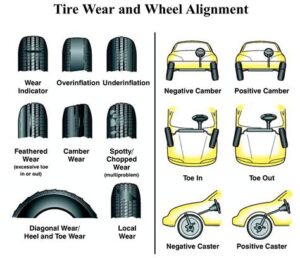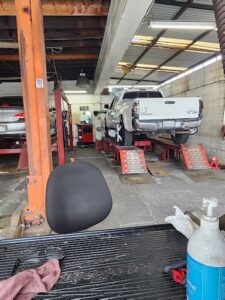How to Know If Your Car Needs Alignment
Maintaining your vehicle’s alignment is essential for ensuring a smooth and safe driving experience. Misalignment can lead to a host of issues, affecting not just your car’s handling but also its tire lifespan and fuel efficiency. In this article, we will explore the common signs indicating that your car may need an alignment, such as unusual tire wear and unexpected noises. We’ll also discuss the importance of regular alignment checks, highlighting the benefits of timely interventions for improved handling and prolonged tire life. By staying informed about your vehicle’s alignment needs, you can enhance your driving experience and avoid costly repairs down the road. Let’s dive in and discover how to keep your car performing at its best!
Signs Your Car Needs Alignment: Common Indicators to Watch For
If you’re wondering how to recognize when your car needs alignment, here are some common signs to be vigilant about:
- Pulling to One Side: If your vehicle drifts to the left or right while driving straight, it’s a strong indication that your alignment might be off.
- Uneven or Rapid Tire Wear: Check your tires for uneven tread wear patterns. If one side is more worn than the other, it’s likely a sign of misalignment.
- Steering Wheel Off-Center: If your steering wheel is not centered when you’re driving straight, alignment issues should be investigated.
- Vibration in the Steering Wheel: Excessive vibration can be a symptom of alignment problems, particularly if it occurs at higher speeds.
- Unusual Noises: Clicking or popping noises when turning could also signal alignment issues, though it could relate to other mechanical problems.
By keeping an eye on these indicators, you can determine how to take timely action and ensure your vehicle remains in optimal condition. Regular checks can prevent potential long-term damage to your tires and suspension system.
How To Identify Uneven Tire Wear and Its Implications
Identifying uneven tire wear is essential for ensuring your vehicle’s alignment is in check. How to spot these irregularities can save you both money and time in the long run. Here are some key indicators of uneven tire wear to look out for:
- On the Outside Edges: If the outer edges of your tires are worn more than the center, this may indicate that your vehicle is under a condition known as toe-in alignment issue.
- On the Inside Edges: Conversely, significant wear on the inner edges suggests a toe-out alignment problem, often related to over-cambered wheels.
- Center Wear: If the center of your tires appears worn, it may suggest over-inflation. Maintaining the correct tire pressure is crucial.
- Patchy Wear Patterns: Irregular patterns, such as cupping or scalloping, might point to issues beyond just alignment, including suspension problems or shock absorber failure.
Each of these wear patterns provides valuable insights into the condition of your vehicle’s alignment and can help in diagnosing other mechanical issues. By keeping an eye on your tires and addressing misalignments early, you can enhance your vehicle’s performance and extend its lifespan.
Listening for Unusual Noises: A Development in Recognizing Alignment Issues
When it comes to how to determine if your car needs alignment, paying attention to unusual noises can be a crucial aspect. If your vehicle is misaligned, it may produce sounds that are not typical of normal driving conditions. Here are some noises to listen for:
- Pulling Sounds: When your car is misaligned, it may create a pulling sensation or noise as it struggles to maintain a straight path. Listen for any sounds that seem to indicate your vehicle is resisting steering inputs.
- Squealing Tires: A common sign of alignment issues is when your tires squeal against the pavement. This noise is often heard during turns or when transitioning between different speeds.
- Clunking or Thumping: If you notice clunking or thumping sounds, particularly when driving over bumps or uneven surfaces, it may signify that your suspension is affected due to misalignment.
- Grinding Noises: Misalignment can put additional strain on vehicle components, leading to grinding noises from the tires or suspension. If you hear this, it’s essential to have your vehicle checked for alignment issues.
Listening for these noises while driving can be an effective method to identify potential alignment problems. If you notice any of these sounds, it’s advisable to consult a professional for a thorough inspection and alignment adjustment.
The Importance of Regular Alignment Checks for Vehicle Performance
Maintaining proper wheel alignment is essential for optimal vehicle performance. One of the primary reasons for regular alignment checks is to ensure safety. When your car is correctly aligned, it tracks straight and true, which improves handling and reduces the risk of accidents caused by loss of control.
Additionally, regular alignment checks contribute to better fuel efficiency. Misaligned wheels can cause your car to work harder than necessary, leading to increased fuel consumption. By ensuring that your wheels are aligned correctly, you can help your vehicle achieve its maximum fuel efficiency, saving you money in the long run.
Furthermore, how to maintain the longevity of your tires is critically linked to alignment. Proper alignment decreases the wear and tear on your tires, allowing them to last longer and perform better. This reduces the need for early tire replacements, which can be a significant expense for car owners.
Neglecting alignment checks can also lead to other issues within your vehicle. For instance, suspension components may wear out more quickly, resulting in costly repairs. By prioritizing regular alignment checks, you can prevent these additional expenses and ensure your vehicle operates smoothly.
Regular alignment checks are crucial for safety, fuel efficiency, tire longevity, and overall vehicle health. Making these checks a part of your routine vehicle maintenance ensures that your car continues to perform at its best and helps you avoid unexpected repair costs.
Benefits of Timely Alignment: Improved Handling and Tire Longevity
Maintaining your vehicle’s alignment is crucial for optimal operation and safety on the road. When you ensure that your car’s wheels are properly aligned, you can enjoy several significant benefits.
Improved handling is one of the most noticeable effects of timely alignment. When all four wheels are aligned correctly, the vehicle steers more responsively, making it easier to handle on various road conditions. Drivers often report a more stable and controlled ride, especially during high-speed maneuvers and sharp turns.
Furthermore, proper alignment plays a vital role in extending the lifespan of your tires. When wheels are misaligned, it can lead to uneven tire wear, which not only shortens the life of the tires but also increases fuel consumption. By ensuring that your car is aligned, you can maximize tire longevity, saving you money in the long run. Regular alignment checks can help identify issues early, allowing for corrections that protect your investment in tires.
Staying on top of your vehicle’s alignment not only enhances driving performance but also promotes longevity for your tires, ultimately leading to a safer and more cost-effective driving experience.
Frequently Asked Questions
What are the signs that indicate my car needs alignment?
Common signs include uneven tire wear, the steering wheel being off-center, or the vehicle pulling to one side while driving.
How can a misaligned car affect my tires?
A misaligned car can lead to uneven tire wear, which may cause the tires to wear out faster and potentially lead to more costly replacements.
How often should I check my car’s alignment?
It’s a good idea to check your car’s alignment at least once a year, or more frequently if you notice any signs of misalignment.
Can hitting a pothole cause my car to be misaligned?
Yes, hitting a pothole or going over a speed bump too quickly can disrupt your vehicle’s alignment.
What should I do if I suspect my car needs an alignment?
If you suspect your car needs an alignment, it’s best to take it to a professional mechanic for an assessment and potential alignment service.
Will misalignment affect my car’s fuel efficiency?
Yes, misalignment can lead to decreased fuel efficiency, as the vehicle may require more effort to go straight.
Are there different types of alignment services available?
Yes, there are typically two main types of alignment services: two-wheel alignment and four-wheel alignment, depending on whether your car is driven by two wheels or all four.





